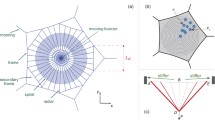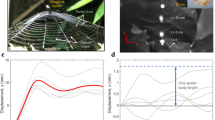Abstract
When the spider orb web stops a prey, the web dissipates impact energy by three routes: internal dissipation within the radial silk, internal dissipation within the spiral silk and aerodynamic dissipation. This paper investigates the energy dissipation mechanism of spider orb webs from the mechanics point of view. Firstly, the dynamic response and energy dissipation of a single spider silk under transverse impact are studied analytically and numerically. The congruence of dynamic response curve validates the accuracy of finite element analysis. Then the whole web is modeled using the finite element method and the respective contribution of each route to total energy dissipation during the simulated prey impact is obtained, which agrees with published experimental results. Finally, the influence of initial impact kinetic energy on the fraction distribution of three routes is demonstrated based on the finite element model. The mechanical mechanism of energy dissipation of spider orb webs is discussed and the reason for the differences among the existing opinions is speculated.
Similar content being viewed by others
References
Wise D H. Spiders in Ecological Webs, Cambridge Univer sity Press, New York, 1993.
Foelix R F. Biology of Spiders, 2nd ed, Oxford University Press, New York, 1996.
Gosline J, Lillie M, Carrington E, Guerette P, Ortlepp C, Savage K. Elastic proteins: Biological roles and mechanical properties. Philosophical Transactions of the Royal Society B, 2002, 357, 121–132.
Omenetto F G, Kaplan D L. New opportunities for an ancient material. Science, 2010, 329, 528–531.
Vollrath F, Porter D. Silks as ancient models for modern polymers. Polymer, 2009, 50, 5623–5632.
Gosline J M, Guerette P A, Ortlepp C S, Savage K N. The mechanical design of spider silk: From fibroin sequence to mechanical function. Journal of Experimental Biology, 1999, 202, 3295–3303.
Sensenig A, Agnarsson I, Blackledge T A. Behavioural and biomaterial coevolution in spider orb webs. Journal of Evolutionary Biology, 2010, 23, 1839–1856.
Tarakanova A, Buehler M J. The role of capture spiral silk properties in the diversification of orb webs. Journal of the Royal Society Interface, 2012, 9, 3240–3248.
Vollrath F. Silk evolution untangled. Nature, 2010, 466, 319.
Hesselberg T, Vollrath F. The mechanical properties of the non-sticky spiral in Nephila orb webs (Araneae, Nephilidae). Journal of Experimental Biology, 2012, 215, 3362–3369.
Blackledge T A, Hayashi C Y. Silken toolkits: Biomechanics of silk fibers spun by the orb web spider Argiope argentata (Fabricius 1775). Journal of Experimental Biology, 2006, 209, 2452–2461.
Blackledge T A, Swindeman J E, Hayashi C Y. Quasistatic and continuous dynamic characterization of the mechanical properties of silk from the cobweb of the black widow spider Latrodectus hesperus. Journal of Experimental Biology, 2005, 208, 1937–1949.
Keten S, Buehler M J. Atomistic model of the spider silk nanostructure. Applied Physics Letters, 2010, 96, 153701.
Bratzel G, Buehler M J. Molecular mechanics of silk nanostructures under varied mechanical loading. Biopolymers, 2011, 97, 408–417.
Keten S, Buehler M J. Nanostructure and molecular mechanics of spider dragline silk protein assemblies. Journal of the Royal Society Interface, 2010, 7, 1709–1721.
Heim M, Keerl D, Scheibel T. Spider silk: From soluble protein to extraordinary fiber. Angewandte Chemie International Edition, 2009, 48, 3584–3596.
Lewis R V. Spider silk: Ancient ideas for new biomaterials. Chemical Reviews, 2006, 106, 3762–3774.
Harmer A M T, Blackledge T A, Madin J S, Herberstein M E. High-performance spider webs: Integrating biomechanics, ecology and behavior. Journal of the Royal Society Interface, 2011, 8, 457–471.
Alexander R M. Tendon elasticity and muscle function. Comparative Biochemistry and Physiology Part A, 2002, 133, 1001–1011.
Roberts T J, Azizi E. Flexible mechanisms: The diverse roles of biological springs in vertebrate movement. Journal of Experimental Biology, 2011, 214, 353–361.
Elices M. Structural Biological Materials: Design and Structure-Property Relationships, Pergamon, Oxford, 2000.
Lin L H, Edmonds D T, Vollrath F. Structural engineering of an orb-spider’s web. Nature, 1995, 373, 146–148.
Alam M S, Jenkins C H. Damage Tolerance in Naturally Compliant Structures. International Journal of Damage Mechanics, 2005, 14, 365–384.
Alam M S, Wahab M A, Jenkins C H. Mechanics in naturally compliant structures. Mechanics of Materials, 2007, 39, 145–160.
Ko F K, Jovicic J. Modeling of mechanical properties and structural design of spider web. Biomacromolecules, 2004, 5, 780–785.
Aoyanagi Y, Okumura K. Simple model for the mechanics of spider webs. Physical Review Letters, 2010, 104, 038102.
Sensenig A T, Lorentz K A, Kelly S P, Blackledge T A. Spider orb webs rely on radial threads to absorb prey kinetic energy. Journal of the Royal Society Interface, 2012, 9, 1880–1891.
Kohler T, Vollrath F. Thread biomechanics in the two orb-weaving spiders Araneus diadematus (Araneae, Araneidae) and Uloborus walckenaerius (Araneae, Uloboridae). Journal of Experimental Zoology, 1995, 271, 1–17.
Agnarsson I, Kuntner M, Blackledge T A. Bioprospecting finds the toughest biological material: Extraordinary silk from a giant riverine orb spider. PloS One, 2010, 5, e11234.
Liu Y, Sponner A, Porter D, Vollrath F. Proline and processing of spider silks. Biomacromolecules, 2008, 9, 116–121.
Liu Y, Shao Z, Vollrath F. Elasticity of spider silks. Biomacromolecules, 2008, 9, 1782–1786.
Denny M. The physical properties of spider’s silk and their role in the design of orb-webs. Journal of Experimental Biology, 1976, 65, 483–506.
Vehoff T, Glisovic A, Schollmeyer H, Zippelius A, Salditt T. Mechanical properties of spider dragline silk: Humidity, hysteresis and relaxation. Biophysical Journal, 2007, 93, 4425–4432.
Swanson B O, Blackledge T A, Summers A P, Hayashi C Y. Spider dragline silk: Correlated and mosaic evolution in high-performance biological materials. Evolution, 2006, 60, 2539–2551.
Swanson B O, Anderson S P, DiGiovine C, Ross R N, Dorsey J P. The evolution of complex biomaterial performance: The case of spider silk. Integrative Comparative Biology, 2009, 49, 21–31.
Swanson B O, Blackledge T A, Hayashi C Y. Spider capture silk: Performance implications of variation in an exceptional biomaterial. Journal of Experimental Zoology, 2007, 307A, 654–666.
Swanson B O, Blackledge T A, Beltran J, Hayashi C Y. Variation in the material properties of spider dragline silk across species. Applied Physics A, 2006, 82, 213–218.
Kelly S P, Sensenig A, Lorentz K A, Blackledge T A. Damping capacity is evolutionarily conserved in the radial silk of orb-weaving spiders. Zoology, 2011, 114, 233–238.
Lin L H, Sobek I W. Structural hierarchy in spider webs and spiderwebs-type systems. Structural Engineering, 1998, 76, 59–64.
Yang Y, Chen X, Shao Z, Zhou P, Porter D, Knight D P, Vollrath F. Toughness of spider silk at high and low temperature. Advanced Materials, 2005, 17, 84–88.
Author information
Authors and Affiliations
Corresponding author
Rights and permissions
About this article
Cite this article
Yu, H., Yang, J. & Sun, Y. Energy absorption of spider orb webs during prey capture: A mechanical analysis. J Bionic Eng 12, 453–463 (2015). https://doi.org/10.1016/S1672-6529(14)60136-0
Published:
Issue Date:
DOI: https://doi.org/10.1016/S1672-6529(14)60136-0




